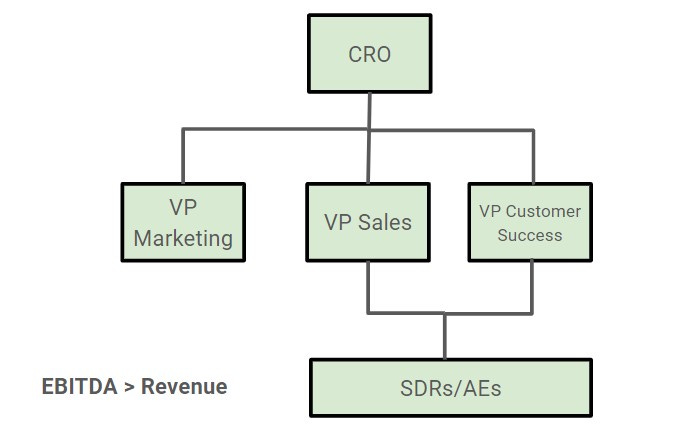#24 - The New CRO
In the era of “growth at all costs” (~2010-2022) CROs were maniacally focused on revenue and new logos. EBITDA be damned.
They led a bloated team of Sales VPs, Regional Managers, AE’s and SDR's.
Commissions were paid once agreements were signed, and the customer was passed over to a siloed customer success organization to handle renewals.
The incentive structure was designed so that sales reps never spoke to their customers again.
i.e. if the customer churned, the revenue org didn’t really care. They already got paid. Seems silly, but that was just the way it was.
CMO’s ran bloated marketing orgs and CCO’s ran professional services and customer success teams (also bloated). Each org was siloed with very loosely aligned incentive structures.
CFOs probably felt icky about the whole thing, but kept quiet knowing that an acquisition or IPO based on top-line growth would make profitability issues go away.
As interest rates spiked the VC and M&A ecosystem froze, enterprise spending dried up, and in a very-short period B2B tech companies needed to rebalance towards profitability.
With growth slowing and runways shortening, layoffs were quickly instituted.
By and large, CROs who were successful and experienced in growing revenue with an unlimited purse were replaced with COOs that could develop and execute against a profitable growth strategy.
2024 and Beyond
In this current era of profitable and efficient growth, how are successful B2B tech companies constructed?
Well, they certainly aren’t bloated.
The siloes between marketing, new client acquisition, RevOps and Customer Success have been removed. The GTM organization is much leaner and the incentives are completely aligned.
Successful CROs in this era, who own Marketing, new business, expansion AND retention must design and incentivize their entire GTM organization to operate accordingly.
Here is a breakdown of how these orgs have evolved:
CROs - They have a larger equity stake. Knowing that acquisitions are now focused on EBITDA multiples, they must construct a profitable GTM org that focuses on acquisition, retention and expansion in equal parts. Ironically, revenue growth is a secondary priority.
Marketing - Remains focused on top-of-funnel, but will be resource-strapped and continuously challenged to ensure any initiative will have ROI. “Best practices” from the golden age will go extinct and will be replaced with scrappier employees and 3rd party agencies expert in creative content creation and alternative distribution channels (i.e. no more spam emails).
Revenue - Slimmed down teams of SDRs and AEs will have compensation structures focused on transactions, expansion AND retention. Commissions will be based on their ability to continually sell value to new and existing customers and will remain a customers main point of contact post-sale. High-volume cold outbound is now extremely commoditized, but still valuable - we’ll see a significant uptick in outsourcing this function.
Customer Success - Will have a VP that reports into the CRO focused on designing, deploying and optimizing best practices for customer retention and expansion. CSM teams that previously reported into them will be dissolved given that the revenue team owns post-sale customer relationships.
RevOps - The CRO’s Robin and their liaison to finance (who now have a lot more say in GTM decision making). They ensure all proposed growth investments are scrutinized, all GTM activity is high-value with significant ROI, and EBITDA growth is healthy.
In this new, un-siloed GTM organization, everyone must be focused on delivering consistent, recurring impact that the customer continually recognizes and values.


